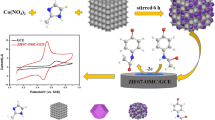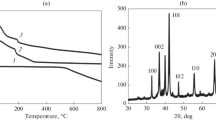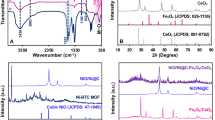Abstract
Three different types of Zr-based MOFs derived from benzene dicarboxylic acid (BDC) and naphthalene dicarboxylic acid as organic linkers (ZrBDC, 2,6-ZrNDC, and 1,4-ZrNDC) were synthesized. They were characterized using X-ray diffraction analysis (XRD), X-ray photoelectron spectroscopy (XPS), Fourier-transform IR spectroscopy (FT-IR), and Transmission electron microscopy (TEM). Their hydrophilic/hydrophobic nature was investigated via contact angle measurements; ZrBDC MOF was hydrophilic and the other two (ZrNDC) MOFs were hydrophobic. The three MOFs were combined with MWCNTs as electrode modifiers for the determination of a hydrophobic analyte, flibanserin (FLB), as a proof-of-concept analyte. Under the optimized experimental conditions, a significant enhancement in the oxidation peak current of FLB was observed when utilizing 2,6-ZrNDC and 1,4-ZrNDC, being the highest when using 1,4-ZrNDC. Furthermore, a thorough investigation of the complex oxidation pathway of FLB was performed by carrying out simultaneous spectroelectrochemical measurements. Based on the obtained results, it was verified that the piperazine moiety of FLB is the primary site for electrochemical oxidation. The fabricated sensor based on 1,4-ZrNDC/MW/CPE showed an oxidation peak of FLB at 0.8 V vs Ag/AgCl. Moreover, it showed excellent linearity for the determination of FLB in the range 0.05 to 0.80 μmol L−1 with a correlation coefficient (r) = 0.9973 and limit of detection of 3.0 nmol L−1. The applicability of the developed approach was demonstrated by determination of FLB in pharmaceutical tablets and human urine samples with acceptable repeatability (% RSD values were below 1.9% and 2.1%, respectively) and reasonable recovery values (ranged between 97 and 103% for pharmaceutical tablets and between 96 and 102% for human urine samples). The outcomes of the suggested methodology can be utilized for the determination of other hydrophobic compounds of pharmaceutical or biological interest with the aim of achieving low detection limits of these compounds in various matrices.
Graphical Abstract









Similar content being viewed by others
Data availability
The manuscript has data that was included as Electronic Supplementary Material.
References
Jayaramulu K, Geyer F, Schneemann A, Kment Š, Otyepka M, Zboril R, Vollmer D, Fischer RA (2019) Hydrophobic metal–organic frameworks. Adv Mater 31:1900820. https://doi.org/10.1002/adma.201900820
Hosseinzadeh B, Rodriguez-Mendez ML (2023) Electrochemical sensor for food monitoring using metal-organic framework materials. Chemosensors 11:357. https://doi.org/10.3390/chemosensors11070357
Sohrabi H, Ghasemzadeh S, Shakib S, Majidi MR, Razmjou A, Yoon Y, Khataee A (2023) Metal–organic framework-based biosensing platforms for the sensitive determination of trace elements and heavy metals: a comprehensive review. Ind Eng Chem Res 62:4611–4627. https://doi.org/10.1021/acs.iecr.2c03011
Kajal N, Singh V, Gupta R, Gautam S (2022) Metal organic frameworks for electrochemical sensor applications: a review. Environ Res 204:112320. https://doi.org/10.1016/j.envres.2021.112320
Chang Y, Lou J, Yang L, Liu M, Xia N, Liu L (2022) Design and application of electrochemical sensors with metal-organic frameworks as the electrode materials or signal tags. Nanomaterials (Basel) 12:3248. https://doi.org/10.3390/nano12183248
Dashtian K, Shahbazi S, Tayebi M, Masoumi Z (2021) A review on metal-organic frameworks photoelectrochemistry: a headlight for future applications. Coord Chem Rev 445:214097. https://doi.org/10.1016/j.ccr.2021.214097
Liu L, Zhou Y, Liu S, Xu M (2018) The applications of metal−organic frameworks in electrochemical sensors. ChemElectroChem 5:6–19. https://doi.org/10.1002/celc.201700931
Xiao J, Luo Y, Su L, Lu J, Han W, Xu T, Zhang X (2022) Hydrophilic metal-organic frameworks integrated uricase for wearable detection of sweat uric acid. Anal Chim Acta 1208:339843. https://doi.org/10.1016/j.aca.2022.339843
Wang Y, Wu Y, Xie J, Hu X (2013) Metal–organic framework modified carbon paste electrode for lead sensor. Sens Actuators B Chem 177:1161–1166. https://doi.org/10.1016/j.snb.2012.12.048
Ma T, Li H, Ma J-G, Cheng P (2020) Application of MOF-based materials in electrochemical sensing. Dalton Trans 49:17121–17129. https://doi.org/10.1039/D0DT03388J
Yang X, Li Q-X, Chi S-Y, Li H-F, Huang Y-B, Cao R (2022) Hydrophobic perfluoroalkane modified metal-organic frameworks for the enhanced electrocatalytic reduction of CO2. SmartMat 3:163–172. https://doi.org/10.1002/smm2.1086
Liu C-S, Li J, Pang H (2020) Metal-organic framework-based materials as an emerging platform for advanced electrochemical sensing. Coord Chem Rev 410:213222. https://doi.org/10.1016/j.ccr.2020.213222
Jayasree D, Ravichandran R (2021) Electrochemical application of zirconium-based metal-organic framework. Inorg Nano-Met Chem 52:1–7. https://doi.org/10.1080/24701556.2021.1916527
He L, Duan F, Song Y, Guo C, Zhao H, Tian J-Y, Zhang Z, Liu C-S, Zhang X, Wang P, Du M, Fang S-M (2017) 2D zirconium-based metal-organic framework nanosheets for highly sensitive detection of mucin 1: consistency between electrochemical and surface plasmon resonance methods. 2D Mater 4:025098. https://doi.org/10.1088/2053-1583/aa6fc6
Su F, Zhang S, Ji H, Zhao H, Tian J-Y, Liu C-S, Zhang Z, Fang S, Zhu X, Du M (2017) Two-dimensional zirconium-based metal–organic framework nanosheet composites embedded with Au nanoclusters: a highly sensitive electrochemical aptasensor toward detecting cocaine. ACS Sens 2:998–1005. https://doi.org/10.1021/acssensors.7b00268
Malekzadeh M, Mohadesi A, Karimi MA, Ranjbar M (2020) Development of a new electrochemical sensor based on Zr-MOF/MIP for sensitive diclofenac determination. Anal Bioanal Electrochem 12:402–414
Gao N, Tan R, Cai Z, Zhao H, Chang G, He Y (2021) A novel electrochemical sensor via Zr-based metal organic framework–graphene for pesticide detection. J Mater Sci 56:19060–19074. https://doi.org/10.1007/s10853-021-06436-6
Li Y, Hu M, Huang X, Wang M, He L, Song Y, Jia Q, Zhou N, Zhang Z, Du M (2020) Multicomponent zirconium-based metal-organic frameworks for impedimetric aptasensing of living cancer cells. Sens Actuators B Chem 306:127608. https://doi.org/10.1016/j.snb.2019.127608
Wang Q, Gu C, Fu Y, Liu L, Xie Y (2020) Ultrasensitive electrochemical sensor for luteolin based on zirconium metal-organic framework UiO-66/reduced graphene oxide composite modified glass carbon electrode. Molecules 25:4557. https://doi.org/10.3390/molecules25194557
Bai Y, Dou Y, Xie L-H, Rutledge W, Li J-R, Zhou H-C (2016) Zr-based metal–organic frameworks: design, synthesis, structure, and applications. Chem Soc Rev 45:2327–2367. https://doi.org/10.1039/C5CS00837A
Simon JA, Kingsberg SA, Shumel B, Hanes V, Garcia M Jr, Sand M (2014) Efficacy and safety of flibanserin in postmenopausal women with hypoactive sexual desire disorder: results of the SNOWDROP trial. Menopause 21:633–640. https://doi.org/10.1097/GME.0000000000000134
US Food And Drug Administration. Label approved on 8/2015. https://www.accessdata.fda.gov/drugsatfda_docs/label/2015/022526lbl.pdf. Last accessed at 15/February/2024.
Drugbank Online Database (Flibanserin). https://go.drugbank.com/drugs/DB04908, Last accessed at 15/February/2024.
Sharma MK, Shah RP, Sengupta P (2020) Amalgamation of stress degradation and metabolite profiling in rat urine and feces for characterization of oxidative metabolites of flibanserin using UHPLC-Q-TOF-MS/MS, H/D exchange and NMR technique. J Chromatogr B 1139:121993. https://doi.org/10.1016/j.jchromb.2020.121993
Sharma MK, Sahu AK, Shah RP, Sengupta P (2021) A systematic UHPLC-Q-TOF-MS/MS based analytical approach for characterization of flibanserin metabolites and establishment of biotransformation pathway. J Chromatogr B 1185:123011. https://doi.org/10.1016/j.jchromb.2021.123011
Ahmed RM, Abdallah IA (2020) Determination of flibanserin in the presence of confirmed degradation products by a third derivative emission spectrofluorometric method: application to pharmaceutical formulation. Spectrochim Acta A Mol Biomol Spectrosc 225:117491. https://doi.org/10.1016/j.saa.2019.117491
Bao Q, Zhao H, Han S, Zhang C, Hasi W (2020) Surface-enhanced Raman spectroscopy for rapid identification and quantification of flibanserin in different kinds of wine. Anal methods 12:3025–3031. https://doi.org/10.1039/d0ay00741b
Ahmed RM, Abdallah IA (2020) Univariate and chemometrics-assisted spectrophotometric methods for determination of flibanserin in a recently released dosage form. J Appl Spectrosc 87:976–985. https://doi.org/10.1007/s10812-020-01097-w
Foudah AI, Shakeel F, Alqarni MH, Alam P (2021) A rapid and sensitive stability-indicating green RP-HPTLC method for the quantitation of flibanserin compared to green NP-HPTLC method: validation studies and greenness assessment. Microchem J 164. https://doi.org/10.1016/j.microc.2021.105960
He L, You W, Wang S, Jiang T, Chen C (2019) A rapid and sensitive UPLC-MS/MS method for the determination of flibanserin in rat plasma: application to a pharmacokinetic study. BMC Chem 13:111. https://doi.org/10.1186/s13065-019-0620-9
Iqbal M, Ezzeldin E, Rezk NL, Bajrai AA, Al-Rashood KA (2018) A validated UPLC–MS/MS method for flibanserin in plasma and its pharmacokinetic interaction with bosentan in rats. Bioanalysis 10:1087–1097. https://doi.org/10.4155/bio-2018-0065
Sultan MA, El-Eryan RT, Attia AK, Eissa MJ (2019) Development and validation of liquid chromatography-electrospray-tandem mass spectrometry method for determination of flibanserin in human plasma: application to pharmacokinetic study on healthy female volunteers. Biomed Chromatogr 33:e4545. https://doi.org/10.1002/bmc.4545
Abdel-aal FAM, Kamel RM, Abdeltawab AA, Mohamed FA, Mohamed A-MI (2023) Polypyrrole/carbon dot nanocomposite as an electrochemical biosensor for liquid biopsy analysis of tryptophan in the human serum of normal and breast cancer women. Anal Bioanal Chem 415:4985–5001. https://doi.org/10.1007/s00216-023-04784-7
Ibrahim H, Temerk Y (2022) Surface decoration of functionalized carbon black nanoparticles with nanosized gold particles for electrochemical sensing of diuretic spironolactone in patient plasma. Microchem J 178:107425. https://doi.org/10.1016/j.microc.2022.107425
de Lima LF, Ferreira AL, Maciel CC, Ferreira M, de Araujo WR (2021) Disposable and low-cost electrochemical sensor based on the colorless nail polish and graphite composite material for tartrazine detection. Talanta 227:122200. https://doi.org/10.1016/j.talanta.2021.122200
Said MI, Abdel-aal FAM, Rageh AH (2020) Novel sponge-like Mn5O8 nanoparticles deposited on graphite electrode for electrochemical study of hepatitis C antiviral drug, elbasvir. Microchem J 157:105056. https://doi.org/10.1016/j.microc.2020.105056
Ibrahim M, Ibrahim H, Almandil NB, Sayed MA, Kawde A-N, Aldaqdouq Y (2020) A novel platform based on Au−CeO2@MWCNT functionalized glassy carbon microspheres for voltammetric sensing of valrubicin as bladder anticancer drug and its interaction with DNA. Electroanalysis 32:2146–2155. https://doi.org/10.1002/elan.202060125
Temerk Y, Ibrahim H, Schuhmann W (2019) Simultaneous anodic adsorptive stripping voltammetric determination of luteolin and 3-hydroxyflavone in biological fluids using renewable pencil graphite electrodes. Electroanalysis 31:1095–1103. https://doi.org/10.1002/elan.201900066
Ibáñez D, González-García MB, Hernández-Santos D, Fanjul-Bolado P (2022) Spectroelectrochemical enzyme sensor system for acetaldehyde detection in wine. Biosensors 12:1032. https://doi.org/10.3390/bios12111032
Garoz-Ruiz J, Perales-Rondon JV, Heras A, Colina A (2019) Spectroelectrochemical sensing: current trends and challenges. Electroanalysis 31:1254–1278. https://doi.org/10.1002/elan.201900075
Hernández CN, Martín-Yerga D, González-García MB, Hernández-Santos D, Fanjul-Bolado P (2018) Evaluation of electrochemical, UV/VIS and Raman spectroelectrochemical detection of Naratriptan with screen-printed electrodes. Talanta 178:85–88. https://doi.org/10.1016/j.talanta.2017.09.004
Borman P, Elder D (2017) Q2(R1) Validation of analytical procedures. In: ICH quality guidelines. pp 127–166. https://doi.org/10.1002/9781118971147.ch5
Han Y, Liu M, Li K, Zuo Y, Wei Y, Xu S, Zhang G, Song C, Zhang Z, Guo X (2015) Facile synthesis of morphology and size-controlled zirconium metal-organic framework UiO-66: the role of hydrofluoric acid in crystallization. CrystEngComm 17:6434–6440. https://doi.org/10.1039/C5CE00729A
Liu M, Zhao Q, Liu H, Yang J, Chen X, Yang L, Cui Y, Huang W, Zhao W, Song A, Wang Y, Ding S, Song Y, Qian G, Chen H, Pan F (2019) Tuning phase evolution of β-MnO2 during microwave hydrothermal synthesis for high-performance aqueous Zn ion battery. Nano Energy 64:103942. https://doi.org/10.1016/j.nanoen.2019.103942
Bumajdad A, Nazeer AA, Al Sagheer F, Nahar S, Zaki MI (2018) Controlled synthesis of ZrO2 nanoparticles with tailored size, morphology and crystal phases via organic/inorganic hybrid films. Sci Rep 8:3695. https://doi.org/10.1038/s41598-018-22088-0
Law K-Y (2014) Definitions for hydrophilicity, hydrophobicity, and superhydrophobicity: getting the basics right. J Phys Chem Lett 5:686–688. https://doi.org/10.1021/jz402762h
Wang TC, Doty FP, Benin AI, Sugar JD, York WL, Reinheimer EW, Stavila V, Allendorf MD (2019) Get the light out: nanoscaling MOFs for luminescence sensing and optical applications. Chem comm 55:4647–4650. https://doi.org/10.1039/C9CC01673B
Valenzuela L, Amariei G, Ezugwu CI, Faraldos M, Bahamonde A, Mosquera MEG, Rosal R (2022) Zirconium-based metal-organic frameworks for highly efficient solar light-driven photoelectrocatalytic disinfection. Sep Purif Technol 285:120351. https://doi.org/10.1016/j.seppur.2021.120351
Said MI, Rageh AH, Abdel-Aal FAM (2018) Fabrication of novel electrochemical sensors based on modification with different polymorphs of MnO2 nanoparticles. Application to furosemide analysis in pharmaceutical and urine samples. RSC Adv 8:18698–18713. https://doi.org/10.1039/c8ra02978d
Aristov N, Habekost A (2015) Cyclic voltammetry - a versatile electrochemical method investigating electron transfer processes. World J Chem Educ 3:115–119. https://doi.org/10.12691/wjce-3-5-2
Brett CMA, Brett AMO (1993) Electrochemistry: principles, methods, and applications. Oxford Science University Publications, Oxford
Bard AJ, Faulkner LR (2001) Electrochemical methods: fundamentals and applications, 2nd edn. John Wiley & Sons, New York
Kauffmann JM, Vire JC, Patriarche GJ, Nunez-Vergara LJ, Squella JA (1987) Voltammetric oxidation of trazodone. Electrochim Acta 32:1159–1162. https://doi.org/10.1016/0013-4686(87)80028-2
Hegde RN, Shetti NP, Nandibewoor ST (2009) Electro-oxidation and determination of trazodone at multi-walled carbon nanotube-modified glassy carbon electrode. Talanta 79:361–368. https://doi.org/10.1016/j.talanta.2009.03.064
Fischer J, González-Martín J, Lochyński P, Dejmková H, Schwarzová-Pecková K, Vega M (2020) Voltammetric study of triazole antifungal agent terconazole on sp3 and sp2 carbon-based electrode materials. J Electroanal Chem 863:114054. https://doi.org/10.1016/j.jelechem.2020.114054
Uslu B, Özkan SA (2002) Electrochemical characterisation of nefazodone hydrochloride and voltammetric determination of the drug in pharmaceuticals and human serum. Anal Chim Acta 462:49–57. https://doi.org/10.1016/S0003-2670(02)00280-5
Ozkan SA, Dogan B, Uslu B (2006) Voltammetric analysis of the novel a typical antipsychotic drug quetiapine in human serum and urine. Microchim Acta 153:27–35. https://doi.org/10.1007/s00604-005-0457-x
Uslu B, Özkan SA (2003) Electroanalytical characteristics of piribedil and its differential pulse and square wave voltammetric determination in pharmaceuticals and human serum. J Pharm Biomed Anal 31:481–489. https://doi.org/10.1016/S0731-7085(02)00725-2
Guidelli R, Compton RG, Feliu JM, Gileadi E, Lipkowski J, Schmickler W, Trasatti S (2014) Defining the transfer coefficient in electrochemistry: an assessment (IUPAC technical report). Pure Appl Chem 86:245–258. https://doi.org/10.1515/pac-2014-5026
Chomisteková Z, Culková E, Bellová R, Melicherčíková D, Durdiak J, Timko J, Rievaj M, Tomčík P (2017) Oxidation and reduction of omeprazole on boron-doped diamond electrode: mechanistic, kinetic and sensing performance studies. Sens Actuators B Chem 241:1194–1202. https://doi.org/10.1016/j.snb.2016.10.014
Jorge SMA, Pontinha ADR, Oliveira-Brett AM (2010) Electrochemical redox behavior of omeprazole using a glassy carbon electrode. Electroanalysis 22:625–631. https://doi.org/10.1002/elan.200900377
Temgoua RCT, Bussy U, Alvarez-Dorta D, Galland N, Hémez J, Thobie-Gautier C, Tonlé IK, Boujtita M (2021) Using electrochemistry coupled to high resolution mass spectrometry for the simulation of the environmental degradation of the recalcitrant fungicide carbendazim. Talanta 221:121448. https://doi.org/10.1016/j.talanta.2020.121448
Martins D, Garrido EMPJ, Borges F, Garrido JMPJ (2021) Voltammetric profiling of new psychoactive substances: piperazine derivatives. J Electroanal Chem 883:115054. https://doi.org/10.1016/j.jelechem.2021.115054
Mahnashi MH, Mahmoud AM, Az A, Alhazzani K, Alanazi SA, Alanazi MM, El-Wekil MM (2021) A novel design and facile synthesis of nature inspired poly (dopamine-Cr3+) nanocubes decorated reduced graphene oxide for electrochemical sensing of flibanserin. Microchem J 164. https://doi.org/10.1016/j.microc.2021.106020
Hosny NM, Ali MFB (2022) Emphasis on the incorporation of tropaeolin OO dye and silver nanoparticles for voltammetric estimation of flibanserin in bulk form, tablets and human plasma. Talanta 245:123420. https://doi.org/10.1016/j.talanta.2022.123420
Acknowledgements
The authors would like to express their sincere thanks to Prof. Hossieny Ibrahim (Professor of Electroanalytical Chemistry, Department of Chemistry, Faculty of Science, Assiut University, Assiut, Egypt) for helping the authors in setting up the SEC apparatus and designing the connections to SEC and electrochemical cells.
Funding
The authors would like to thank the German Federal Ministry for Economic Cooperation and Development (BMZ) for funding the purchase and donation of the Gamry Interface 1010E Potentiostat/Galvanostat/ZRA model and Flame S-UV–VIS spectrometer (with the connected accessories) via the German Academic Exchange Service (Deutscher Akademischer Austauschdienst – DAAD), Bohn, Germany.
Author information
Authors and Affiliations
Contributions
Azza H. Rageh: conceptualization, funding acquisition, data curation, formal analysis, validation, investigation, methodology, writing—original draft, and writing—review and editing. Mohamed I. Said: conceptualization, funding acquisition, data curation, formal analysis, validation, investigation, methodology, writing—original draft and writing—review and editing. Fatma. A.M. Abdela-aal: conceptualization, funding acquisition, data curation, formal analysis validation, investigation, methodology, writing—original draft, and writing—review and editing.
Corresponding author
Ethics declarations
Conflict of interest
The current study is new, original, and not under consideration elsewhere. Its publication has been approved by all co-authors. The authors declare that they have no known competing financial interests or personal relationships that could have appeared to influence the work reported in this paper.
Additional information
Publisher's Note
Springer Nature remains neutral with regard to jurisdictional claims in published maps and institutional affiliations.
Supplementary Information
Below is the link to the electronic supplementary material.
Rights and permissions
Springer Nature or its licensor (e.g. a society or other partner) holds exclusive rights to this article under a publishing agreement with the author(s) or other rightsholder(s); author self-archiving of the accepted manuscript version of this article is solely governed by the terms of such publishing agreement and applicable law.
About this article
Cite this article
Rageh, A.H., Said, M.I. & Abdel-aal, F.A.M. Zirconium-based hydrophobic-MOFs as innovative electrode modifiers for flibanserin determination: Exploring the electrooxidation mechanism using a comprehensive spectroelectrochemical study. Microchim Acta 191, 236 (2024). https://doi.org/10.1007/s00604-024-06297-1
Received:
Accepted:
Published:
DOI: https://doi.org/10.1007/s00604-024-06297-1




